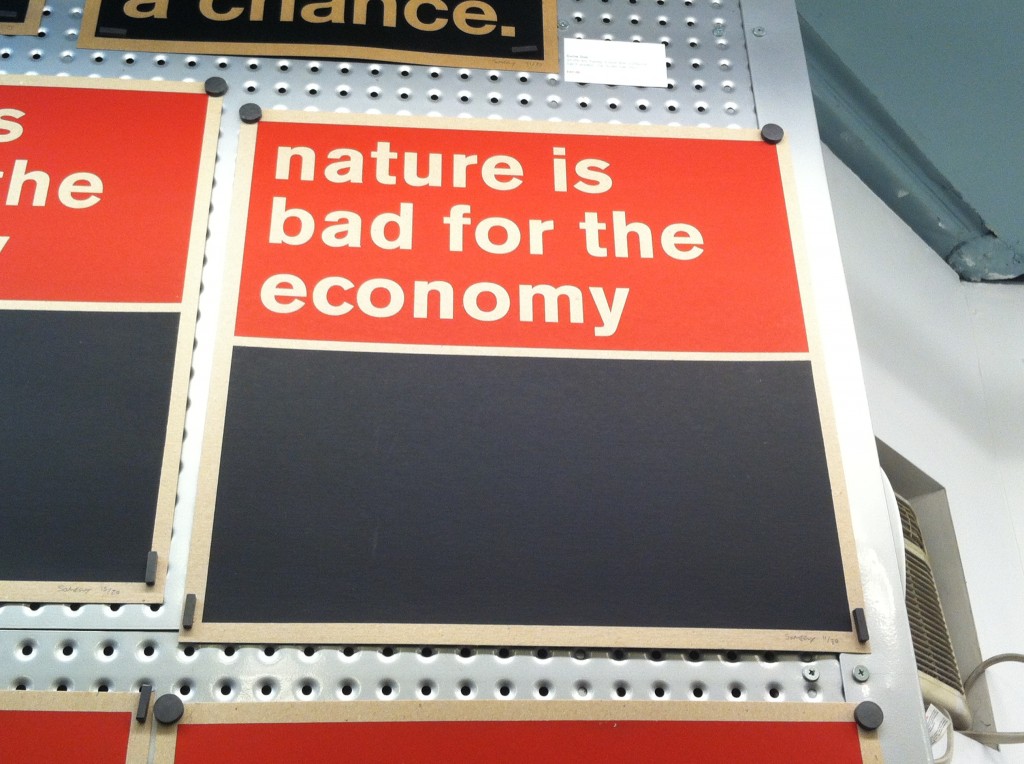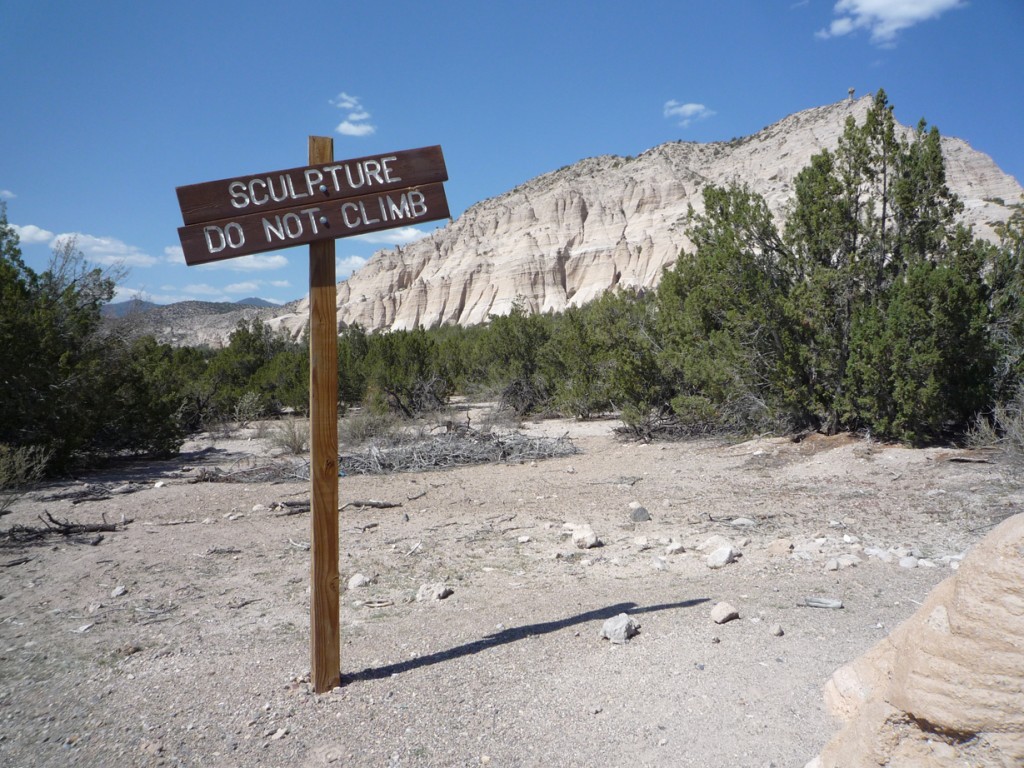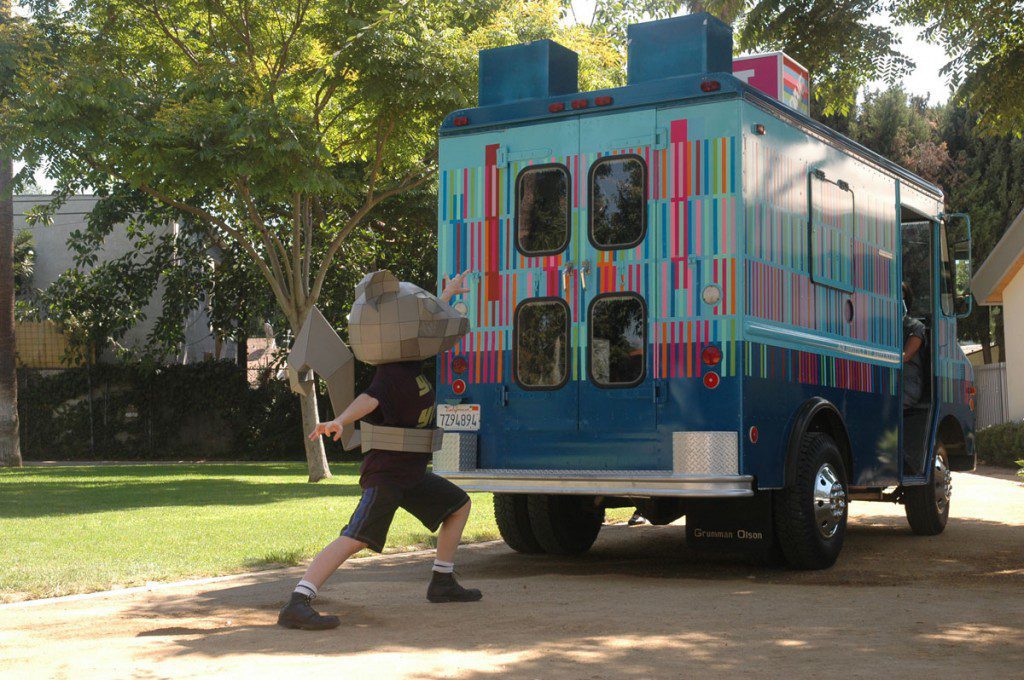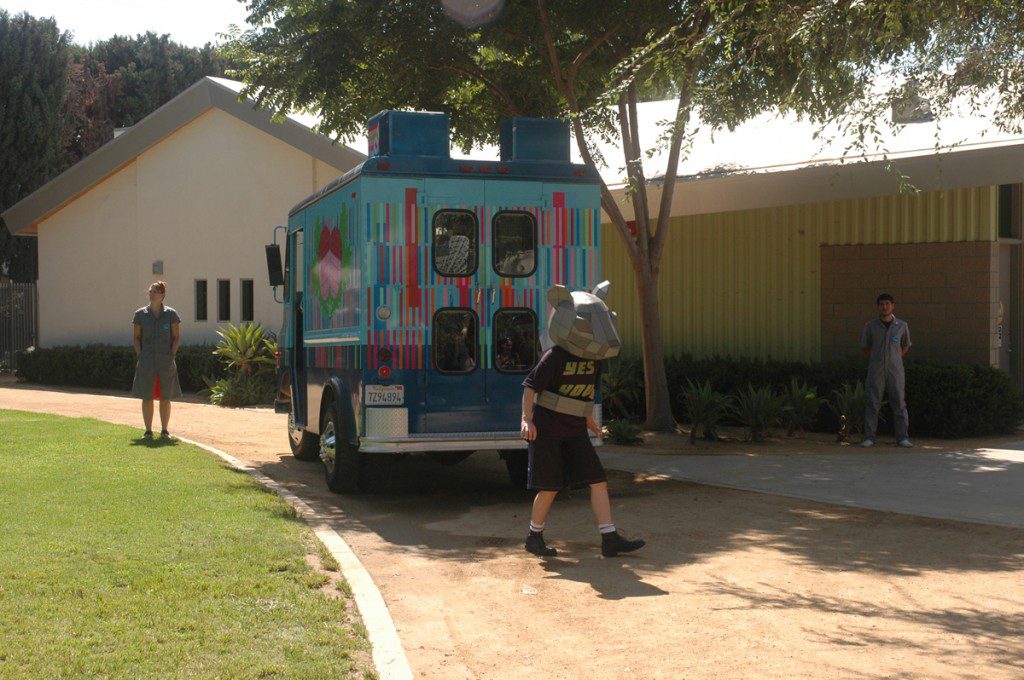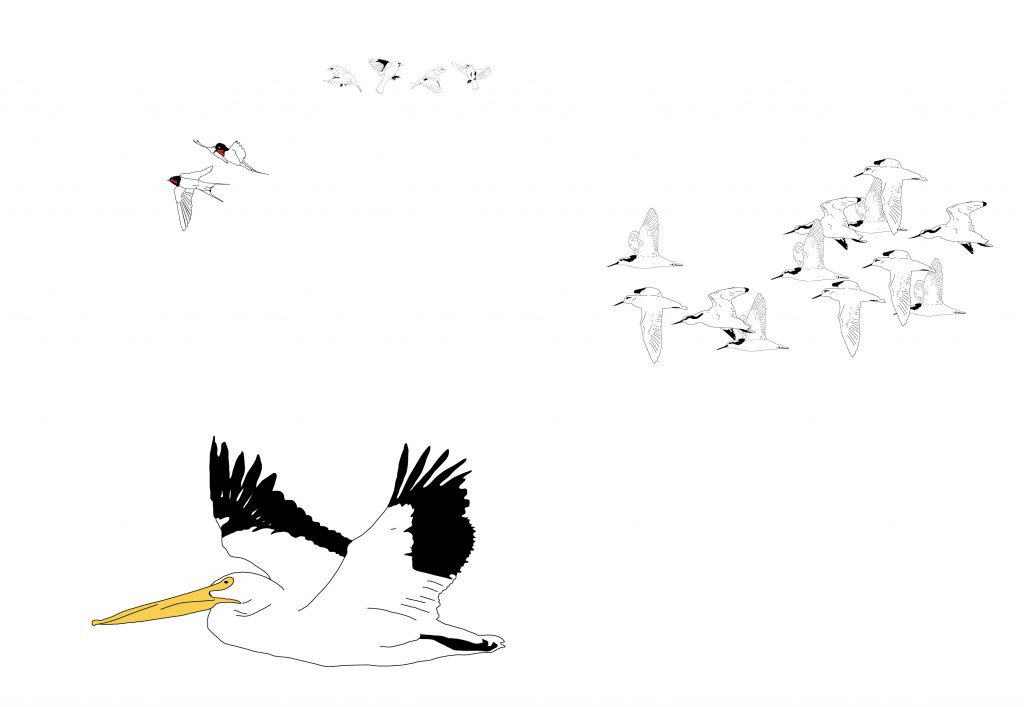Research Journal
-
September 26, 2012
Bash, Cash, and Crash
Tags:“Weather surgeons draw silk through needles, close the eye of the storm.”
– Karen An-hwei Lee, from the poem Dream of InflationI came across a particularly virulent strain of enviro-bashing in the work of Telegraph.co.uk pundit James Delingpole, who has authored, among other things:
Watermelons: The Green Movement’s True Colors
(find out what global warming ‘climate change’ is really all about)We all bash, but I know my position is the right path – I can adopt a middle path in terms of understanding the other side, but why wouldn’t we err towards stewardship instead of exploitation? Why busy one’s self with conspiracy theories? Is everything about ripping off the freedom of the little guy who may maybe maybe maybe, one far away day, get rich off the same things with which his overlords rule? I know, this is naïve and sincere, but there you go.
There are other economies than the ones most of us engage in, that foster more care about one’s larger community.
See:The Money Fix, Alan Rosenblith
(one of the great questions Rosenblith asks is whether the KIND of item chosen to stand in as money affects the behavior of the people inside that economy?)
WATCH FILMMoney is at the intersection of nearly every aspect of modern life. Most of us take the monetary system for granted, but it has a profound and largely misunderstood influence on our lives. THE MONEY FIX is a feature-length documentary exploring our society’s relationship with the almighty dollar.
THE MONEY FIX examines economic patterning in both the human and the natural worlds, and through this lens we learn how we can empower ourselves by redesigning the lifeblood of the economy at the community level. The film documents three types of alternative money systems, all of which help solve economic problems for the communities in which they operate.
-
September 24, 2012
To be one with a tiger in a cage
Tags:NY Times yesterday:
The police said on Saturday that they issued a desk appearance ticket for criminal trespass to a man who leapt from a monorail into a tiger enclosure at the Bronx Zoo on Friday.
Paul J. Browne, the chief police spokesman, said in an e-mail that the man, David Villalobos of Mahopac, N.Y., appeared to have a “passion for cats.”
According to Mr. Browne, Mr. Villalobos told investigators that the leap into the enclosure was motivated by a desire to be “one with the tiger.”
On Friday afternoon, Mr. Villalobos, 25, got on the Wild Asia Monorail, which glides over about 40 acres of open space, then jumped as it passed the tiger habitat. He cleared a 16-foot fence and landed near a 400-pound Siberian tiger named Bachuta.
Bachuta attacked Mr. Villalobos, who suffered a broken pelvis, a broken right shoulder, a broken right rib, a collapsed lung and a broken right ankle, which was also mauled by the tiger.
Mr. Browne said that Mr. Villalobos told the police that the jump caused most of his injuries.
“When an N.Y.P.D. sergeant asked Villalobos yesterday why he had jumped into the tiger preserve, he replied that ‘everyone in life makes choices,’ ” Mr. Browne wrote, adding: “He recalled being dragged by the tiger by the foot, and afterwards being able to pet the tiger.”
From an earlier NYT report on the incident:
Mr. Villalobos’s Facebook page is filled with tributes to nature and images of tigers and other wild animals. One picture of wolves carries the caption: “Love the animals. God has given them the rudiments of thought and joy untroubled. Don’t trouble it, don’t harass them, don’t deprive them of their happiness.”Mr. Villalobos was in stable condition at Jacobi Medical Center on Saturday.
-
-
-
September 6, 2012
you thunk it was junk.
Tags:I love people. This happened rather quickly – which is fantastic – the things scientists called ‘junk’ in our DNA are starting to reveal themselves. I love people for needing to dismiss things as junk, and simultaneously having a nagging dogged curiosity: naah, that can’t ALL be junk.
Two articles this month:
1. Time Mag
Junk. Barren. Non-functioning. Dark matter. That’s how scientists had described the 98% of human genome that lies between our 21,000 genes, ever since our DNA was first sequenced about a decade ago. The disappointment in those descriptors was intentional and palpable.
It had been believed that the human genome — the underpinnings of the blueprint for the talking, empire-building, socially evolved species that we are — would be stuffed with sophisticated genes, coding for critical proteins of unparalleled complexity. But when all was said and done, and the Human Genome Project finally determined the entire sequence of our DNA in 2001, researchers found that the 3 billion base pairs that comprised our mere 21,000 genes made up a paltry 2% of the entire genome. The rest, geneticists acknowledged with unconcealed embarrassment, was an apparent biological wasteland.
But it turns out they were wrong. In an impressive series of more than 30 papers published in several journals, including Nature, Genome Research, Genome Biology, Science and Cell, scientists now report that these vast stretches of seeming “junk” DNA are actually the seat of crucial gene-controlling activity — changes that contribute to hundreds of common diseases. The new data come from the Encyclopedia of DNA Elements project, or ENCODE, a $123 million endeavor begun by the National Human Genome Research Institute (NHGRI) in 2003, which includes 442 scientists in 32 labs around the world. MORE
NY Times, “Bits of Mystery DNA, Far From ‘Junk,’ Play Crucial Role”
Now scientists have discovered a vital clue to unraveling these riddles. The human genome is packed with at least four million gene switches that reside in bits of DNA that once were dismissed as “junk” but that turn out to play critical roles in controlling how cells, organs and other tissues behave. The discovery, considered a major medical and scientific breakthrough, has enormous implications for human health because many complex diseases appear to be caused by tiny changes in hundreds of gene switches. MORE
-
August 26, 2012
It’s official! Animals *DO* have consciousness.
Tags:Prominent Scientists Sign Declaration that Animals have Conscious Awareness, Just Like Us
George Dvorsky, IO9, Aug 25, 2012An international group of prominent scientists has signed The Cambridge Declaration of Consciousness in which they are proclaiming their support for the idea that animals are conscious and aware to the degree that humans are — a list of animals that includes all mammals, birds, and even the octopus.
Add’l essay: Octopuses Gain Consciousness According to Scientists Declaration, Katherine Harmon, Scientific American, August 21, 2012
“The weight of evidence indicates that humans are not unique in possessing the neurological substrates that generate consciousness,” the scientists wrote. “Non-human animals, including all mammals and birds, and many other creatures, including octopuses, also possess these neurological substrates.”
The octopus is the only invertebrate to get a shout-out at all. And plenty of research has been accumulated to back up this assertion. A 2009 study showed that some octopuses collect coconut shells to use as portable shelters—an example of tool use, according to the researchers. Other research has documented sophisticated spatial navigation and memory. Anecdotal reports from researchers, such as Jennifer Mather, describe watching octopuses in the wild make errands to collect just the right number of rocks to narrow the opening to a desired den. And laboratory experiments show a distinct change in behavior when octopuses are kept in tanks that do not have enough enrichment objects to keep them stimulated.
What about Humboldt squid? What about Deleuzian pack-conciousness?
-
August 26, 2012
bring the parasites back inside us
Tags:New connections are being made between inflammation in the womb and the occurrence of autism in offspring. My ears perk up, as I see how many Chinese herbs are used to treat various inflammatory conditions (or general ones) and some of those botanical sources are highly invasive species, who thrive in disturbed, adverse, declined, urban, asthmatic ecosystems (see Invasive Plant Medicine for a treatise and list by herbalist Tim Scott) .
from
“An Immune Disorder at the Root of Autism,” The New York Times, Aug 26, 2012:More recently, William Parker at Duke University has chimed in. He’s not, by training, an autism expert. But his work focuses on the immune system and its role in biology and disease, so he’s particularly qualified to point out the following: the immune system we consider normal is actually an evolutionary aberration.
Some years back, he began comparing wild sewer rats with clean lab rats. They were, in his words, “completely different organisms.” Wild rats tightly controlled inflammation. Not so the lab rats. Why? The wild rodents were rife with parasites. Parasites are famous for limiting inflammation.
Humans also evolved with plenty of parasites. Dr. Parker and many others think that we’re biologically dependent on the immune suppression provided by these hangers-on and that their removal has left us prone to inflammation. “We were willing to put up with hay fever, even some autoimmune disease,” he told me recently. “But autism? That’s it! You’ve got to stop this insanity.”
What does stopping the insanity entail? Fix the maternal dysregulation, and you’ve most likely prevented autism. That’s the lesson from rodent experiments. In one, Swiss scientists created a lineage of mice with a genetically reinforced anti-inflammatory signal. Then the scientists inflamed the pregnant mice. The babies emerged fine — no behavioral problems. The take-away: Control inflammation during pregnancy, and it won’t interfere with fetal brain development.
For people, a drug that’s safe for use during pregnancy may help. A probiotic, many of which have anti-inflammatory properties, may also be of benefit. Not coincidentally, asthma researchers are arriving at similar conclusions; prevention of the lung disease will begin with the pregnant woman. Dr. Parker has more radical ideas: pre-emptive restoration of “domesticated” parasites in everybody — worms developed solely for the purpose of correcting the wayward, postmodern immune system.
Practically speaking, this seems beyond improbable. And yet, a trial is under way at the Montefiore Medical Center and the Albert Einstein College of Medicine testing a medicalized parasite called Trichuris suis in autistic adults.
First used medically to treat inflammatory bowel disease, the whipworm, which is native to pigs, has anecdotally shown benefit in autistic children.
And really, if you spend enough time wading through the science, Dr. Parker’s idea — an ecosystem restoration project, essentially — not only fails to seem outrageous, but also seems inevitable.
Since time immemorial, a very specific community of organisms — microbes, parasites, some viruses — has aggregated to form the human superorganism. Mounds of evidence suggest that our immune system anticipates these inputs and that, when they go missing, the organism comes unhinged.
Future doctors will need to correct the postmodern tendency toward immune dysregulation. Evolution has provided us with a road map: the original accretion pattern of the superorganism. Preventive medicine will need, by strange necessity, to emulate the patterns from deep in our past.
Addendum: Colleague Marianne Petit sent me a link to a blog post taking this article apart. Such a good comeuppance for me, to remember to distinguish between exciting poetics, and well-wrought scientific inquiry:
Emily Willingham, Autism, immunity, inflammation, and the New York Times
As he closes with two paragraphs in which he uses, without preamble, the word “superorganism” twice, Velasquez-Manoff then violates science yet again by calling this plan to colonize all people with worms an “ecosystem restoration project.” Never mind the plain fact that you simply can’t go home again when it comes to ecosystems and that colonizing our guts with pig parasites isn’t exactly replaying our evolutionary history. Either way, we are not the organisms we were 10,000 years ago or even 1000 years ago, not even counting the worms, and we won’t be again. Talking about “days of yore” and “time immemorial” doesn’t backtrack the collective changes our species has accumulated since the good old days of rampant parasitic infestations and high infant mortality. And my hope is that articles like this one won’t backtrack us to viewing all of autism as rooted in immune dysfunction and find ourselves once again staring into the abyss of vaccine panic.What we have here is an argument that relies on shaky and shifting hypotheses of autism and autoimmune epidemics and hygiene, built using sparse data and scientific hints, a poor understanding of basic evolution and ecology, and a paradox of calling for a return to a more infectious past to “cure” autism while blaming immune-dysregulated, occasionally infected mothers of the present for … autism. In his closing, Velasquez-Manoff argues that evolution provided us with a roadmap of the original microbial and parasitic ecosystems we once were, one that, presumably, if we follow it, will guide us out of the “insanity” and “affliction” that is autism. If it’s possible, that’s where he’s most wrong. Evolution isn’t something that happens with a plan. To describe it in those terms is to have a profound failure of understanding of what evolution is. Where we’re going, evolutionarily speaking, there are no roads. And it would be better for most of us if there weren’t any parasitic worms, either. -
August 26, 2012
Monkeys in Parliament
Tags:
SACRED MONKEY: A family walked out of the Lord Hanuman temple in the Karol Bagh neighborhood in New Delhi Tuesday. The monkey god is one of the most revered in Hinduism. (Kevin Frayer/Associated Press) From The New York Times, May 22 2012:
“They were totally silent, very quick and highly effective.”
The monkey population of Delhi has grown so large and aggressive that overwhelmed city officials have petitioned India’s Supreme Court to relieve them of the task of monkey control.
“We have trapped 13,013 monkeys since 2007,” said R. B. S. Tyagi, director of veterinary services for Delhi’s principal city government. Nonetheless, Delhi’s monkey population has only increased.
The reason is simple: People feed them. Monkeys are the living representatives of the cherished Hindu god Hanuman, and Hindu tradition calls for feeding monkeys on Tuesdays and Saturdays.
Dr. Tyagi expressed impatience with residents who feed the monkeys one day, then complain to the city when the monkeys steal their clothes on another day.
Dr. Tyagi’s agency has asked the city’s wildlife agency for help, but wildlife officials claim that the monkeys — a scourge of the city for years as urbanization has encroached on their original habitat — are no longer wild and are thus not their responsibility.
–The New York Times, “Indians Feed the Monkeys, Which Bite the Hand”

-
August 24, 2012
Stupid Animal Trick: Flying Sheep and Deer Among Hawaii’s Islands – NYTimes.com
Tags:Stupid Animal Trick: Flying Sheep and Deer Among Hawaii’s Islands – NYTimes.com.
A helicopter pilot is pleading guilty to illegally flying deer from Maui to the Big Island, shedding light on a mystery that has been bewildering Hawaii: how did axis deer, an animal that can’t swim across the ocean, get to another island? But now federal authorities say the people behind the scheme also took several mouflon sheep from the Big Island and flew them to Maui.
Neither axis deer nor mouflon sheep are native to Hawaii and don’t have natural predators here. Their presence has damaged fragile native ecosystems and farms on the islands where they’ve become established. The alleged animal smugglers took the sheep to a Maui hunting ranch, and apparently didn’t release them into the wild. Even so, the sheep’s arrival on Maui for the first time deeply concerns conservationists who fear that the animals could escape or give others the idea to bring over more.
-
July 30, 2012
birds
Tags:I’ve picked up on Flight, a project I am working on with Paul Paradiso.
There are going to be a lot of forthcoming bird animations…
